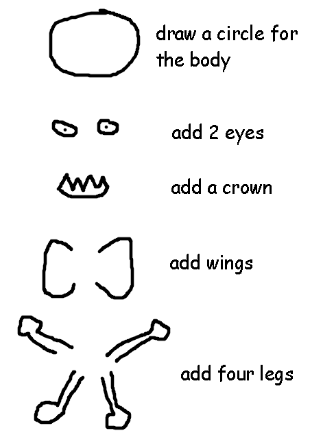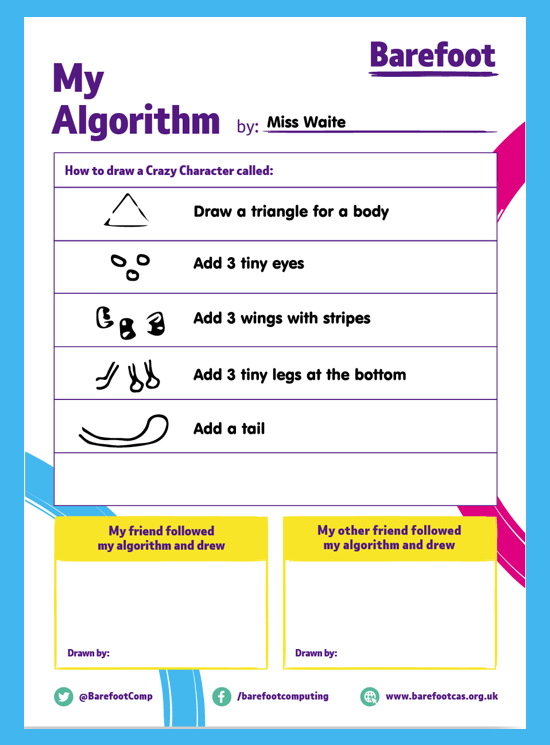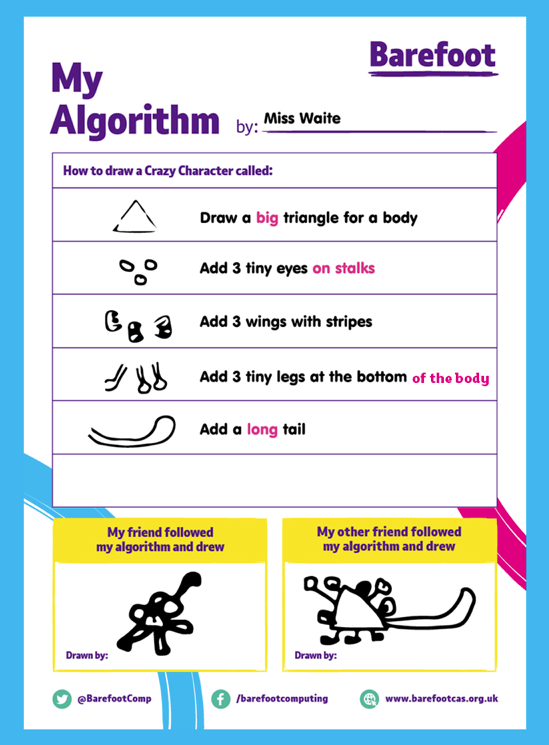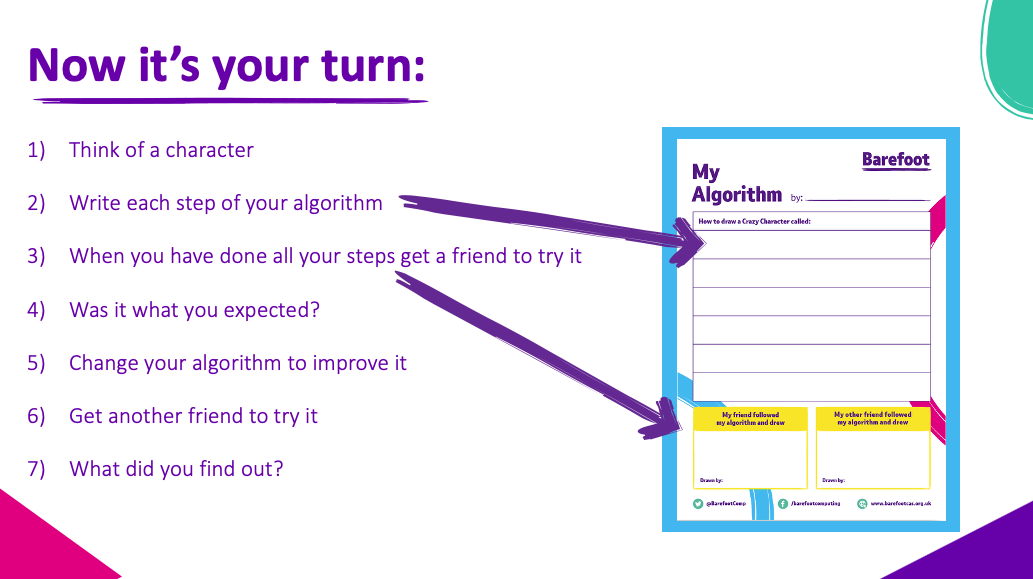Crazy Characters
Action Algorithms! - Lesson 1
A note about this lesson
![]()
This lesson has been taken and adapted from Barefoot Computing. Barefoot resources are made available under Open Government licensing.
THE ORIGINAL LESSON PLAN CAN BE FOUND HERE. You can access more resources by creating a FREE account on the Barefoot website. You can do this easily at http://barefootcas.org.uk/
Objectives
- To know what an algorithm is
- To write an algorithm
- To use an algorithm
- To improve an algorithm
Lesson Resources
- Lesson Slides
- Crazy Character Worksheet
- Pencils or pens
Lesson 1 - Crazy Characters
Lesson 2 - Recipe Algorithms
Lesson 3 - Sharing Sweets
Lesson 4 - The Human Crane
Lesson 5 - Action Sequences
Lesson 6 - Programming Dance
Before you start
Make up the crazy character algorithm example you are going to model. You could pop it on a whiteboard page or on a flipchart – but keep hidden until after the pupils have followed it.
An algorithm is a precisely defined sequence of instruction or a set of rules for performing a specific task. This is an ‘unplugged’ activity, which means you do not need a computer. By teaching this short unplugged activity your pupils will create a set of instructions on how to draw a crazy character and so start to understand what algorithms are. Note: You can use any set of instructions to introduce algorithms!
Teacher has created an algorithm, pupils use it.
Bring children to the carpet with a whiteboard and pen each. Explain you are going to teach them a new word – can they listen out for it?
Explain the lesson is going to be about instructions, and that they are going to have to follow some instructions to draw something. Explain to children you have thought of a secret crazy character and you would like to share it with them. You are not going to let them just copy it.
Say you have already created an algorithm to help them draw it. Just slip the word in and see if anyone spots it. Once they spot it, have a little chat about what this word might mean.
Share the learning intentions in the teacher presentation if this is your normal practice. Don’t explain algorithms yet.
Say you are going to use the algorithm now. Read out your steps giving them time to draw each stage. Be bossy and don’t give them extra detail. At the end, show them your algorithm.

Ask children to show you what they have drawn so that you can model saying if it is or is not what you expected. e.g. “Oh I didn’t expect that they would all be different. I wanted the legs all around like Charlie’s and tiny eyes. I wanted tiny striped wings too, but a big crown.”
How you could change your algorithm so that it is what you wanted? Pupils should start to realise the need for precision in algorithms. Model adding extra words in e.g. tiny, at the top etc. Ask what was the algorithm?
Explain that an algorithm is a list of instructions or a set of rules to make something happen or work something out.
Say that the class will be finding out more about algorithms. Explain that they are used to using computer programs and soon the class will be writing programs. To do this well, they will need to practise making algorithms.
Main task - Shared class creation of algorithm
Tell pupils we are going to create instructions on how to draw a class crazy character. Explain you are going to use a worksheet to help set out the work. Using the example in the teacher presentation, Model how to create the instructions step by step as follows:

Model how to imagine/think of a character, e.g. How about a triangle bodied character with wings, as shown below. His name is Tribob. Add the name to the title line.
Then model how to create the step-by-step instructions (the algorithm). Note: we are creating the instructions to draw the character. Ask should we start with the instruction to draw a head or body first? Take ideas and then write the instruction ‘draw a triangle for a body’ add a shape too if your children think this will help. What should the instructions for the eyes be? Add the instruction ‘add three tiny eyes’. Then perhaps an instruction for wings, legs etc.
Explain the boxes at the bottom are for a partner to try out the algorithm. Now ask your TA or a pupil to follow the algorithm and draw the character in one of the bottom boxes.
Then ask, ‘Is that what I expected?’ Model how to think through each step and think about adding detail (precision). Think about how people will understand (interpret) the words we use e.g. add eyes on stalks.
Ask a pupil to use the improved algorithm to draw the character again – in the second box.

Pupils create algorithm
Ask pupils to think of a crazy character and explain that it is their turn to write the instructions.
Remind them to think of simple instructions that their partners will understand. When they have written their algorithm they can ask a friend test it for them. Remind them to think, “Is this what I expected?” Then they can improve their steps and get another friend to test it. (This is the start of learning to debug.)

Then send pupils to their tables with a worksheet each to create their own algorithms.
Mini plenaries: ask pupils to think about how they are improving their algorithm. Are they thinking carefully about what words to use to explain each step clearly so that their tester will know what to draw? Show examples of how pupils have changed their algorithms to make them easier to understand. Ask pupils for examples of things that happened that they did not expect.
Plenary
Bring children back to the carpet with their algorithms. Ask children to tell their carpet partner how their algorithm changed and why. Select a few children to talk about what they tested and how the algorithm changed. What kinds of words were added (position, size, number etc)? How did these help? What happened that they did not expect? What did they do to change their algorithm? Did it work?
Ask children what an algorithm is. A set of precise instructions or rules to work out a problem.
